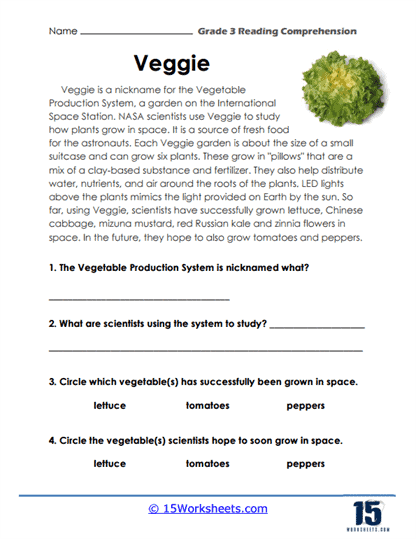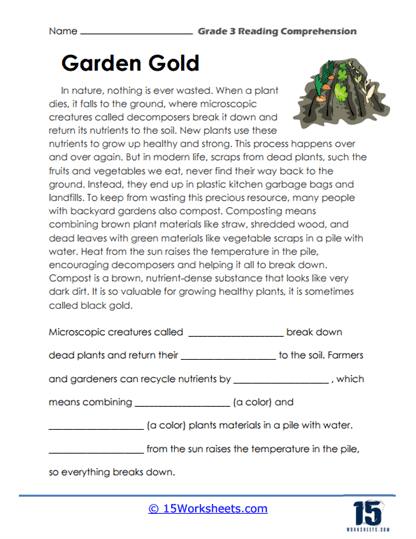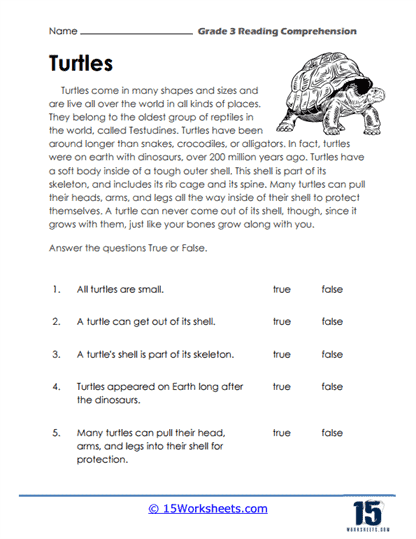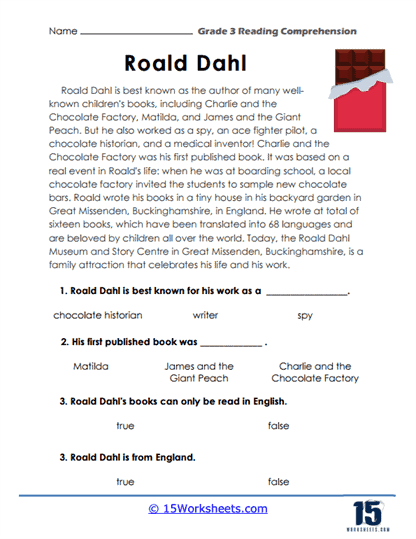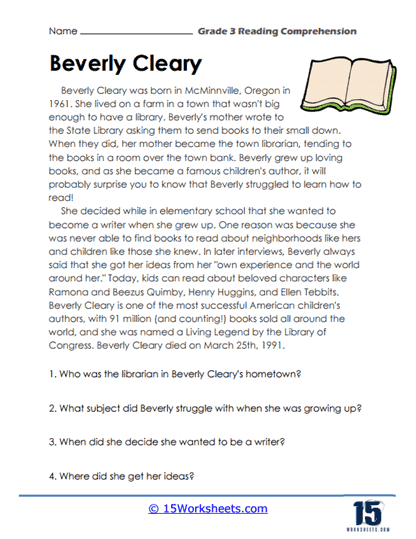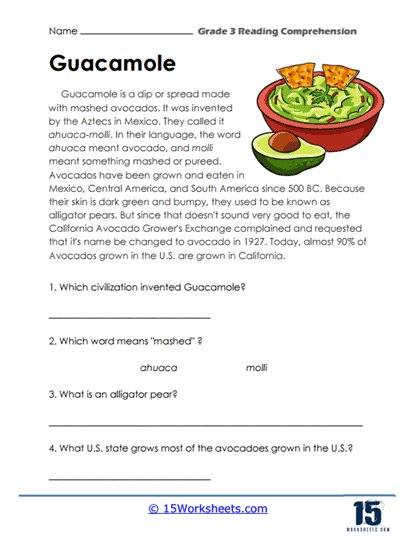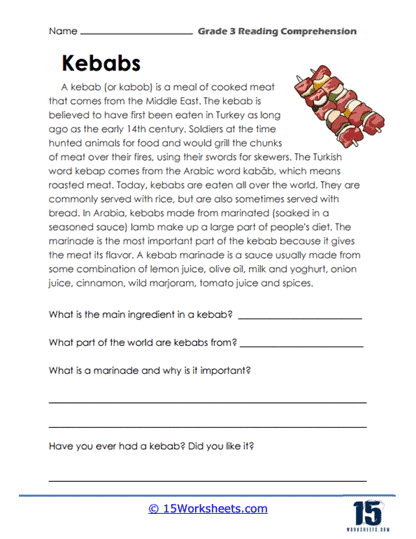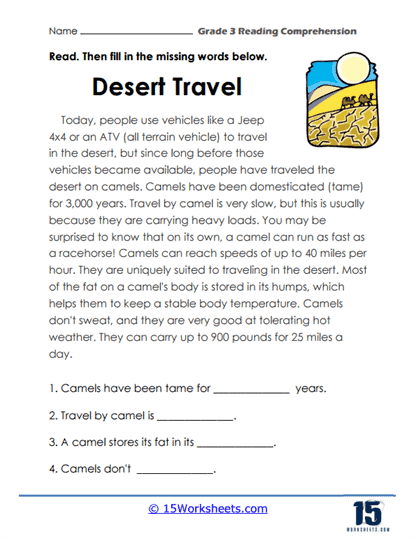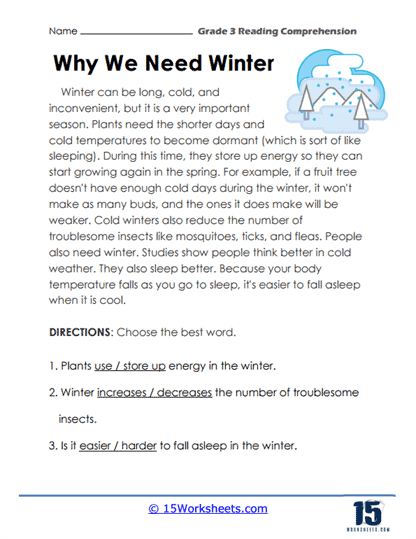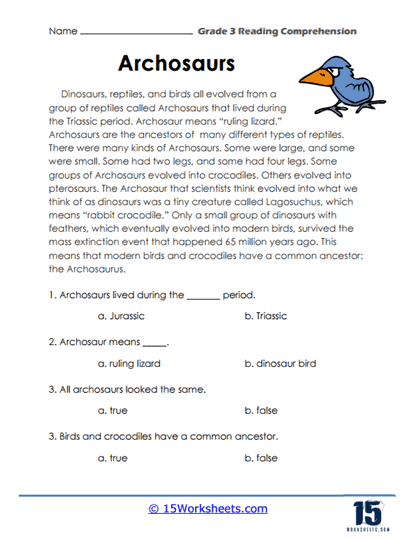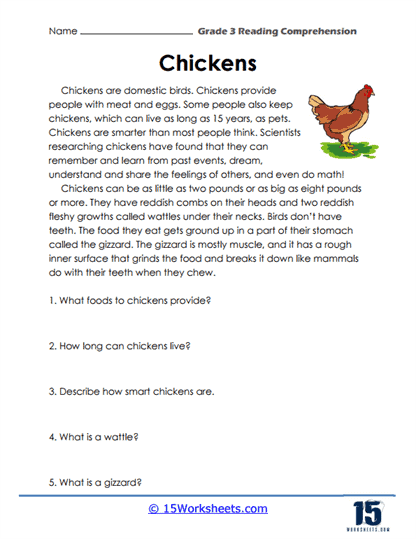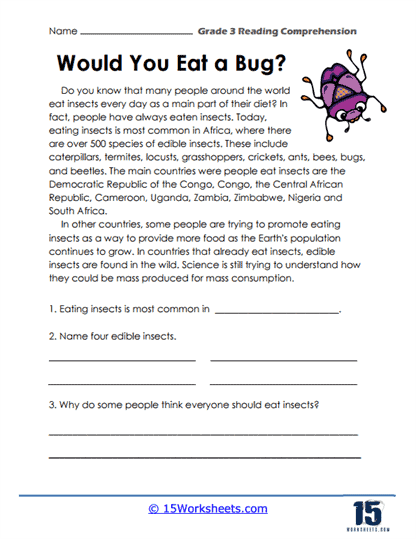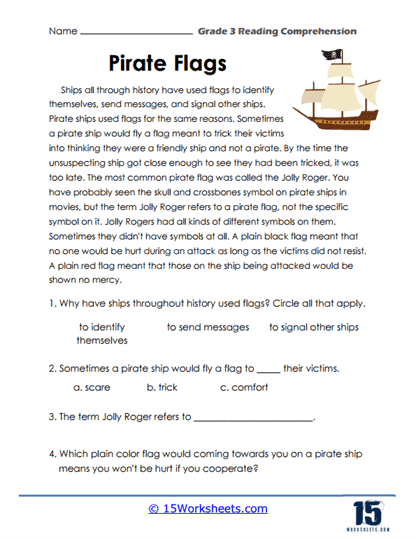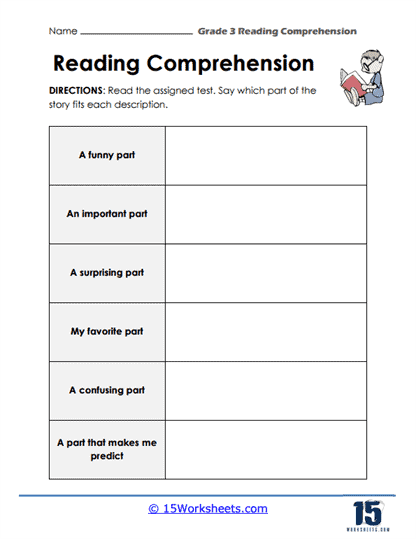Grade 3 Reading Comprehension Worksheets
All About These 15 Worksheets
Our Grade 3 reading comprehension worksheets were developed with a crucial goal in mind: to help young readers not only practice their reading skills but also build their ability to deeply understand and engage with the text they encounter. At this stage of their educational journey, third-grade students are transitioning from simply learning to read, to reading in order to learn. These worksheets, therefore, play a pivotal role in developing and sharpening their comprehension abilities.
The texts provided in these worksheets are intentionally more complex and nuanced than those in earlier grades. Third graders are introduced to longer passages that present a wider variety of ideas and require more critical thinking. These passages might span across diverse genres and subjects, from the adventures of fictional characters to factual accounts of historical events or scientific phenomena. But the heart of the worksheets lies in the questions that follow. These questions prompt students to pause, reflect, and assess their understanding of what they’ve read, making the practice of comprehension both structured and challenging.
By the time a child reaches third grade, they should be developing fluency in reading, which means not only reading words accurately but also with appropriate speed, expression, and intonation. This fluency is important because it allows students to focus less on decoding individual words and more on the meaning behind the words. A fluent reader knows when to slow down to savor a particularly tricky or important sentence, and when to speed up during action-packed or straightforward sections. As students encounter new words, their expanding vocabulary gives them the tools to infer the meaning of unfamiliar terms using context clues, or by breaking down the words into roots, prefixes, and suffixes. This ability is crucial for comprehension because it enables students to understand increasingly complex texts without getting bogged down by unfamiliar language.
Comprehension is not a passive process; it requires active engagement with the material. Grade 3 students should be able to identify the main idea of a passage—the central message or concept that the author wants to convey. They should also pick out supporting details, those pieces of evidence or examples that bolster the main idea. Additionally, distinguishing between facts and opinions becomes an important skill. For example, in a passage about dinosaurs, students should recognize that “Dinosaurs lived millions of years ago” is a fact, while “Dinosaurs are the coolest animals ever” is an opinion.
These worksheets encourage students to make connections across texts. They may be asked to compare and contrast themes, characters, or events, which helps deepen their understanding and allows them to see patterns or differences in literature and informational texts. This is also where critical thinking skills come into play. Inference, or the ability to read between the lines, becomes increasingly important. Students may be asked to infer a character’s feelings based on their actions or deduce the consequences of a scientific experiment based on the evidence presented. Similarly, recognizing cause-and-effect relationships within a text helps students understand the logic and flow of events or arguments. Understanding the author’s point of view, whether in fiction or non-fiction, adds yet another layer of comprehension, allowing students to appreciate the motivations and biases that may influence how a story is told or information is presented.
An exciting feature of third-grade reading comprehension is the exposure to different genres. Students dive into the rich world of fiction, exploring stories that take them on journeys to imaginary lands or through historical events, while also learning the structure and tone of non-fiction, poetry, and informational texts. Each genre offers a unique set of challenges and opportunities for comprehension. Fiction often requires students to follow character development and plot twists, while non-fiction may demand a focus on absorbing factual information and understanding it within a broader context.
If we think about reading as a treasure hunt, then reading comprehension is the process of uncovering the treasure hidden in the words on a page. This treasure can come in many forms—sometimes it’s the thrill of a new story unfolding, other times it’s the satisfaction of learning a fascinating new fact. But to uncover that treasure, students need a strategy: they need to know how to extract meaning from the text. The comprehension questions in these worksheets serve as their map, guiding them to dig deeper into the material and focus on what truly matters. Every time a student answers a question correctly, they are one step closer to understanding the “treasure” that the passage holds.
The questions following each passage are where the magic of learning truly happens. These questions vary in complexity and aim to challenge different aspects of a student’s understanding. Some questions are straightforward, asking students to recall specific facts or details from the text. For example, a passage about space exploration might ask students to name the first astronaut to walk on the moon or list the planets in our solar system. Other questions require students to make predictions—what might happen next in the story based on the clues the author has left? Prediction questions engage students’ ability to think ahead and make logical guesses about outcomes, a skill that strengthens their overall comprehension.
Then there are inference questions, which ask students to go beyond what is directly stated in the text. These questions require them to use clues from the passage to draw conclusions or understand a deeper meaning that isn’t explicitly spelled out. For instance, a student might infer a character’s mood based on how they speak or act, or they might deduce the author’s opinion on a subject based on the way information is presented.
These worksheets serve a dual purpose: they not only test comprehension but also foster skill development in several critical areas. Vocabulary development is one such area. By encountering new words in context, students expand their word bank and learn to figure out meanings using contextual clues. Words like “photosynthesis” in a passage about plant biology or “evaporate” in a weather report not only teach students specific content but also introduce them to new linguistic concepts.
Critical thinking is another key skill fostered through these exercises. Whether it’s determining why a certain historical event happened or evaluating the motivations of a character in a story, students are required to think beyond the surface level of the text. True-or-false and multiple-choice questions push students to weigh different pieces of information and make logical conclusions based on the evidence in the text.
Equally important is the attention to detail that these worksheets cultivate. Some questions direct students to locate specific pieces of information within the text—perhaps identifying which animals hibernate in winter or noting the specific dates of important events. These exercises encourage close reading, which helps students become more meticulous and thoughtful in their approach to reading.
When it comes to completing the worksheets, students should adopt a strategic, step-by-step approach. They begin by reading the passage carefully, absorbing the main points and getting a sense of the structure. Afterward, reviewing the questions allows them to focus on what to look for when revisiting the text. Some questions may require a simple fact or detail, while others involve more complex tasks like drawing connections or making inferences. If necessary, students should be encouraged to reread the passage, especially when questions ask them to dig deeper into the text’s meaning. Lastly, answering in complete sentences reinforces the importance of clarity and precision in both thought and communication.
How Can 3rd Graders Improve Their Reading Skills?
Improving reading skills in 3rd graders involves a combination of targeted practice, engaging activities, and support from teachers, parents, or caregivers. Here are some strategies to help 3rd graders improve their reading skills:
Encourage Daily Reading – Set aside a specific time each day for reading, and make it a routine. This can be independent reading, shared reading with an adult, or even listening to audiobooks.
Choose Age-appropriate and Diverse Materials – Select a variety of books, articles, and stories that match the child’s reading level and interests. Introduce different genres, themes, and cultures to keep reading engaging and enjoyable.
Practice Reading Aloud – Reading aloud helps improve fluency, expression, and comprehension. Encourage the child to read aloud, and take turns reading to each other to make it a fun and interactive activity.
Discuss the Text – After reading, engage the child in a conversation about the story. Ask open-ended questions that promote critical thinking and comprehension, such as “What did you learn from the story?” or “How did the characters change?”
Develop Vocabulary – Introduce new words and phrases in context and help the child understand their meanings. Encourage them to use new words in their conversations and writing.
Use Graphic Organizers – Visual tools like Venn diagrams, story maps, and sequence charts can help children organize their thoughts and better understand the text.
Teach Reading Strategies – Teach the child strategies like summarizing, predicting, visualizing, and making connections to improve their comprehension skills.
Provide a Supportive Environment – Create a comfortable and quiet space for reading, and be patient and positive when offering guidance or feedback.
Monitor Progress – Regularly assess the child’s reading progress through informal observations, quizzes, or discussions. Offer feedback and adjust instruction as needed.
Collaborate with Educators – Stay in close communication with the child’s teacher to understand their strengths and areas of improvement, and work together to develop a plan to support their reading development.
What Reading Skills Do 3rd Graders Learn?
Third grade is a pivotal year for students in terms of reading. In fact, it’s often said that up until third grade, students are learning to read, but starting in third grade, they are reading to learn. Here are some key reading skills that students in third grade are expected to master:
Fluency – Fluency is the ability to read a text accurately, quickly, and with expression. By the end of third grade, students are expected to read grade-level text with purpose and understanding, and with appropriate pacing, intonation, and expression. They should be able to use context to confirm or self-correct word recognition and understanding, rereading as necessary.
Comprehension – Comprehension skills become more complex in third grade. Students should be able to answer questions to demonstrate understanding of a text, referring explicitly to the text as the basis for the answers. They will be expected to retell stories and recount details, and should be able to determine the main idea of a text and explain how it is supported by key details. They should also be able to describe characters in a story and explain how their actions contribute to the sequence of events.
Decoding and Phonics – By third grade, students are expected to have a good command of more advanced phonics rules. They should be able to identify and know the meaning of common prefixes and suffixes, and be able to decode words with those prefixes and suffixes. They should also be able to decode multisyllable words.
Vocabulary – In terms of vocabulary, third graders should be able to determine or clarify the meaning of unknown and multiple-meaning word and phrases based on grade 3 reading and content. They should be choosing flexibly from a range of strategies such as using sentence-level context as a clue to the meaning of a word or phrase, using glossaries or beginning dictionaries, both print and digital, to determine or clarify the precise meaning of key words and phrases.
Text Analysis – Third graders begin to analyze text more deeply. They should be able to distinguish their own point of view from that of the narrator or those of the characters. They should also be able to explain how specific aspects of a text’s illustrations contribute to what is conveyed by the words in a story (e.g., create mood, emphasize aspects of a character or setting).
Reading Different Types of Text – By the end of third grade, students should be comfortable reading and understanding different types of text, including fiction, non-fiction, and poetry. They should be able to compare and contrast the themes, settings, and plots of stories written by the same author about the same or similar characters.
By the end of third grade, students should have these core reading skills well in hand, as they form the basis for more advanced reading and comprehension in the grades to come.
Overall, this is not just a collection of worksheets; it is a comprehensive resource that empowers third-grade students to develop strong reading comprehension skills, setting them on a path towards academic excellence and a lifelong love for reading.
By nurturing critical thinking, vocabulary growth, and a deep connection with literature, this collection equips students with the tools they need to excel in their studies and become avid, capable readers
This series of 15 worksheets underscores the enduring importance of reading comprehension as a foundation for lifelong learning and success, making it an invaluable asset for educators, parents, and young learners alike.

